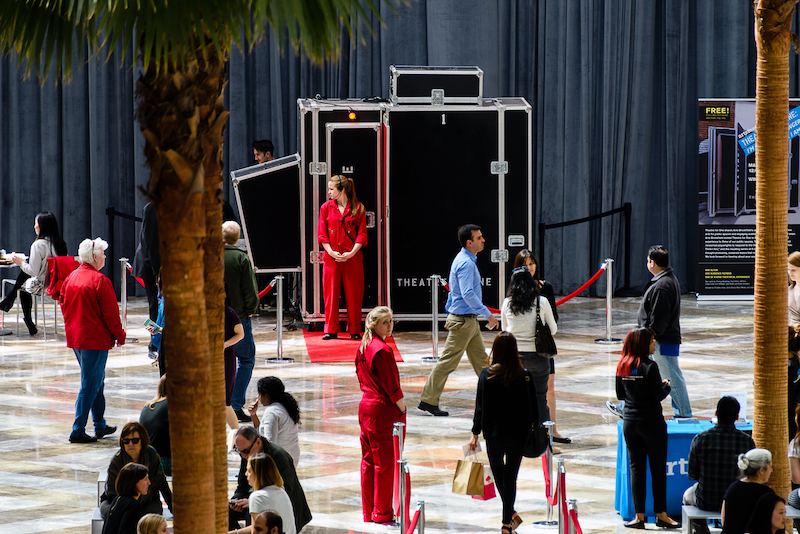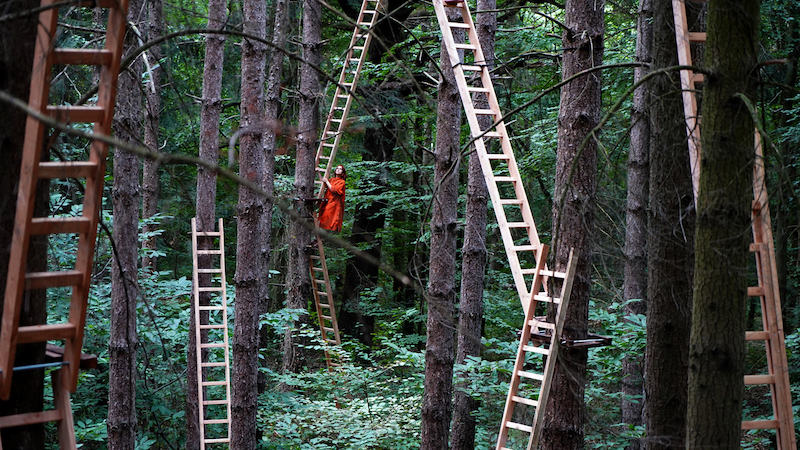Chicago Architecture Biennial Announces Its Fifth Edition


CAB 5 will kick off on September 21st with installations and programs held at sites across the city, leading up to a citywide opening celebration on
November 1st as exhibitions are unveiled at the Chicago Cultural Center and the Graham Foundation.
Via PR — The Chicago Architecture Biennial announced a phased opening plan and newly extended dates for its fifth edition, CAB 5: This is a Rehearsal, along with details on more than 100 cultural partners that will present programming in coordination with this year's citywide exhibition. Reflecting the 2023 Biennial’s theme of architecture as a time-based, iterative practice, CAB 5 will open in two phases. Beginning September 21st—building upon the decentralized model of the previous Biennial—CAB 5 will launch installations at locations across the city with sites activated throughout the fall with public programming from community and cultural partners. To further amplify public engagement and participation, CAB will hold a citywide opening celebration on November 1st, activating all of the Biennial’s City Sites concurrent with the opening of extensive CAB exhibitions at the Chicago Cultural Center and the Graham Foundation. The Cultural Center exhibition will remain on view through February 11, 2024. More details about the full Biennial program and schedule of events will be announced in September.
Dispersed across locations throughout the city of Chicago, This is a Rehearsal’s horizontal approach demonstrates a commitment to engaging multiple publics and practices while inviting visitors to understand architecture through the city. Under the Artistic Direction of the Chicago-based artist collective, Floating Museum, CAB 5 will feature the work of more than 80 local and international participants at locations ranging from outdoor community sites to exhibitions spaces that span across the Loop, Lakeview, Gold Coast, Devon Avenue, Bronzeville, Englewood, South Chicago, Hyde Park, Grand Crossing, and North Lawndale. Through the lens of rehearsal, Floating Museum invites new possibilities through myriad partnerships to generate new dialogues about creative invention. Each program encourages the public to participate in a process of learning and discovery to collectively explore questions such as ways for how the city can be an active participant in conversations about healthy food production, water reclamation, and material production, as well as critical discussions about power and the construction of history in relation to land rights, access, and use.
“The Chicago Architecture Biennial has many audiences, all of which enhance our city. In addition to being a vital part of Chicago’s arts and cultural environment, the Biennial is an important element of attracting tourists, drawing visitors from across the country and throughout the world. Closer to home, the Biennial’s partnerships with community arts organizations enrich our neighborhoods. Together they focus on architecture and design to address the issues which confront urban areas everywhere. I look forward to the product of these mutual efforts,” said Mayor Brandon Johnson.
“Floating Museum is interested in what the complex apparatus of a biennial can do, as a feedback loop to rehearse how the city thinks of itself, as a way to invest in long-term relationships, in addition to the topics it can address,” shared Floating Museum in a joint statement. “With CAB 5—as we center relationships between architectural process, community, and cities as sites of perpetual transformation—it’s only fitting that the Biennial embrace a novel exhibition format that highlights local partners and communities across Chicago, and invite the public to navigate a tapestry of geographically organized experiences that showcase Chicago's creative spirit and potential. Now both decentralized and transitory, we hope the Biennial will live and breathe with the city, and evolve as we continue to collectively rehearse architecture in pursuit of new solutions, systems of care, and improvements to urban life.”
“The Biennial’s partnerships with both world-renowned and community-based arts and cultural venues across Chicago add a diversity of ideas to an exposition intended to foster an international dialogue on architecture in the city known for groundbreaking, innovative design,” added CAB Chairman Jack Guthman. “We greatly value these alliances—and the generous support from the city and state and the foundations, corporations and individual donors whose contributions sustain the CAB exhibition and programs.

Programs Organized with 2023 Cultural Partners & City Sites Include:
Through the curatorial framework, the Floating Museum has invited institutions as participants to the exhibition. Local organizations include Grow Greater Englewood, Urban Growers Collective, Project Onward, SpaceShift, and the Southside Community Art Center. CAB 5 will also present work developed by New York-based organizations such as Storefront for Art and Architecture, The Highline, and the Buell Center at Columbia University. The participant projects will bring direct interventions into the urban landscape, coordinated in partnership with local community organizations through exhibitions, installations, programs, and performance, all with the intent to rehearse the ways in which the architectural process can positively impact local communities.
Partnerships with city sites such as Urban Growers Collective (UGC) will explore topics including urban agriculture and land renewal. In a collaboration between UGC and New York-based studio New York-based architect David Benjamin and Columbia GSAPP’s Footprint Project, CAB 5 will reveal a new outdoor art studio and culinary space to establish an arts residency program that is informed by nature, vision, and communal sharing of diverse narratives. This new space will support emergent collaborations on the seven-acre South Chicago Farmadjacent to Clara Shafer Park. Further expanding on the regenerative and liberatory capacity of rebuilding urban land, the Boston-based landscape design firm Stoss Landscape Urbanism will explore the capacity for urban-ecological transformation through two public forestry initiatives that showcase the benefits of nurturing woodland nurseries and embracing decay's rejuvenating effects. Stoss will cultivate a circular, new-growth forest installation called The Woodland Circle. To accompany the reimagined public green space, in an under-utilized alleyway adjacent to the Field, Stoss will present Tree Cycles—an installation of public seating that utilizes trees at all stages of their life cycles.
SpaceShift, a creative hub for experimentation, will present Shamiana, an immersive multi-sensory public art installation and community gathering space in Chicago’s South Asian neighborhood on Devon Avenue—an area that concurrently serves as a portal for immigrants and refugees to Chicago. With support from Good City Group, the structure will create space for a place for gathering and growth, continuing SpaceShift’s placemaking in the neighborhood.
In partnership with the Poetry Foundation, Theatre for One—a mobile, state-of-the-art performance space for one actor and one audience member, created by Christine Jones and designed by LOT-EK—will feature local Chicago poets and actors performing new poems commissioned by Theatre For One, as well as a new sound installation created by Andrew Schneider activating poetry and connectivity across the city at select sites. Similarly, GELITIN, will activate a major new sculpture that will make a series of brief guest appearances at select Biennial sites. The sculpture will be included in an exhibition at the Neubauer Collegium that will open on September 23 and remain on view through January 12, 2024.
This year CAB will feature programs and exhibitions from long-time partners such as the Chicago Architecture Center, the Art Institute of Chicago, the Museum of Contemporary Art Chicago, the Chicago Humanities Festival, Hyde Park Art Center, Volume Gallery, the National Public Housing Museum and Villa Albertine. Returning CAB partner 6018NORTH will present Water, an exhibition that positions the Chicago River as a point of entry for exploring how the city and its people can be stewards of water and of the greater environment. Organized in collaboration with artist and architect Jennifer Buyck, curator Tricia Van Eck, and French-American residency program Villa Albertine, the exhibition and accompanying public programs aim to reveal how water can be re-examined, better understood, and re-imagined, so that we can become better stewards of water and all that it connects.
CAB and Chicago’s Department of Cultural Affairs and Special Events (DCASE) will continue to expand the partnership as the Biennial’s official Presenting Partner at the Chicago Cultural Center through collaborations around exhibitions and programs and a residency at the Chicago Cultural Center Learning Lab with Mobile Makers. New forms of partnerships are being developed by a suite of other city governmental branches: the Chicago Department of Transportation (CDOT), the Chicago Department of Planning and Development (DPD), and the Chicago Department of Buildings (DOB). Through these partnerships, CAB is rehearsing ways to produce cultural experiences that intersect with city initiatives.
2023 Biennial Partners:
150 Media Stream
6018North
Alliance Française de Chicago
ALLL x Leapfrog Project
Anna & Frederick Douglass Pavilion
ArchAgenda
archKIDecture
The Arts Club of Chicago
Art Institute of Chicago
Art on the Mart
Association for Community Design
Association of Architecture Organizations
Black Arts Consortium at Northwestern University
Buddy
Canopy
Center for Native Futures
Chicago Architectural Club
Chicago Architecture Center
Chicago Collections Consortium
Chicago Department of Buildings
Chicago Department of Cultural Affairs and Special Events
Chicago Department of Housing
Chicago Department of Planning and Development
Chicago Department of Streets and Sanitation Bureau of Forestry
Chicago Department of Transportation
Chicago Humanities Festival
Chicago International Film Festival
Chicago Loop Alliance
Chicago Park District
Chicago Women in Architecture
Cultural Services French Embassy, Chicago
DePaul Museum of Art
Design Museum of Chicago
Design Trust Chicago
DuSable Black History Museum and Education Center
Edith Farnsworth House
European Cultural Centre
Experimental Sound Studio
EXPO CHICAGO
Galaudet Gallery
Gallery 400 at the University of Illinois at Chicago
Glessner House
Goethe-Institut Chicago
GOOD CITY GROUP
Graham Foundation for Advanced Studies in the Fine Arts
Grow Greater Englewood
Human Scale
Hyde Park Arts Center
Illinois Chapter of the National Organization of Minority Architects (I-NOMA)
Illinois Institute of Technology College of Architecture
Independent Curators International (ICI)
Istituto Italiano di Cultura a Chicago
Jane Addams Hull-House Museum
Joffrey Ballet
Lampo
Latent
Lawndale Pop-Up Spot
Marwen
MAS Context
meme01
Memorial Nature Fund
Metrotopia Metaverse
Mobile Makers
Museum of Contemporary Art Chicago
Museum of Contemporary Photography
National Museum of Mexican Art
National Museum of Puerto Rican Arts and Culture
National Organization of Minority Architects
National Public Housing Museum
Neubauer Collegium for Culture and Society
NEXT.cc STEAM by DESIGN
Open Architecture Collaborative - Chicago
OPEN Center for the Arts
PLAMEN Art Foundation
Poetry Foundation
Project HOOD
Richard H. Driehaus Museum
Riverside Arts Center
Royal Society of Arts
School of the Art Institute of Chicago at Homan Square
School of the Art Institute of Chicago Departments. of Sculpture and Visual and Critical Studies
Society for Contemporary Art
Society of Architectural Historians
SOM
South Side Community Art Center
SpaceShift
Steel Studio
Studio Gang
Terrain Biennial 2023
Territory NFP
The Open Practice Committee in the Department of Visual Arts at The University of Chicago
The Renaissance Society
Theater on the Lake
Toronto Biennial of Art
University of Illinois Chicago School of Architecture
University of Illinois Urbana-Champaign School of Architecture
Urban Growers Collective
Villa Albertine
Volume Gallery
Wayfinding
Woman's Athletic Club of Chicago
Wrightwood 659







